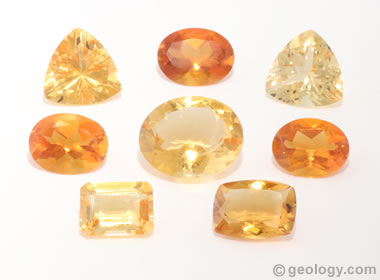
Faceted Citrine: A collection of faceted citrine gems in colors ranging from pale yellow to a rich orange. The oval in the center measures 12 millimeters by 10 millimeters.
What Is Citrine?
Citrine is a transparent variety of quartz with a yellow to orange color. Its attractive color, high clarity, low price, and durability make it the most frequently purchased yellow to orange gem.
Citrine is also a modern birthstone for the month of November. Its designation as a birthstone contributes to its popularity and drives a large number of sales.
Table of Contents
The Citrine Color Range
Citrine's color ranges from yellow, to orangey yellow, to yellowish orange, to brownish orange. The name citrine is used for any transparent quartz in that color range - regardless of its saturation. Stones with a faint color and stones with a rich color are all called "citrine".
The quality of a stone's color has an enormous impact on its price. Stones with a faint color are abundant and inexpensive. Stones with a rich, uniform color are rare, valuable, and preferred by buyers.
Reddish orange and reddish brown are rare colors in quartz. Gems of these reddish colors are often called Madeira citrine. The name is after wines of similar color made in the Madeira Islands, an autonomous region of Portugal, located in the North Atlantic Ocean about 450 miles southwest of Portugal. You can see several nice examples of Madeira citrine in an article titled "Make Mine Madeira" on the JCK Blog.
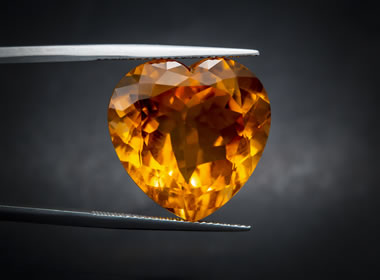
Faceted Citrine Heart: Citrine cut into a heart-shaped gem. Image copyright iStockphoto / wirachai moontha.
Birthstone of November
Citrine and topaz both serve as birthstones for the month of November. Topaz was one of the original modern birthstones selected by the National Association of Jewelers in 1912. Citrine was added to the modern birthstones list in 1952.
Citrine and topaz are both available in the yellow to orange color range, but citrine generally has a much lower cost. Citrine has a Mohs hardness of 7 and topaz has a Mohs hardness of 8. That information might make some people believe that topaz has a higher durability than citrine. However, topaz is a brittle mineral that easily breaks by cleavage. It has little, if any, durability advantage over citrine.
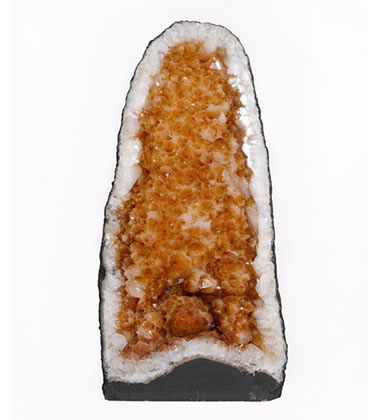
Citrine Geode: Geodes of citrine and amethyst up to several feet tall are usually offered for sale at the Tucson Gem and Mineral Show and other popular mineral shows. The photo above shows a citrine geode that has been cut and prepared to stand in your den or living room. Almost all citrine geodes are discovered with amethyst inside, but are heat treated to convert the purple amethyst into orangy brown citrine. Photograph by Greg C. Grace / Alamy.
Citrine Geodes
One of the most impressive specimens of citrine that you might encounter is a large citrine geode from Brazil. These are often offered for sale at major gem and mineral shows. Gem hunters find these geodes in the Brazilian basalt fields, then clean and prepare them to stand as a crystal tower in your living room. They can be two, or four, or six feet tall - or taller.
Surprisingly, they are not filled with orange to orangy brown citrine when they are found. Instead, most are filled with purple amethyst crystals. Somewhere between discovery and the consumer, a decision is made to heat the geodes in industrial ovens to convert the original purple amethyst into an orangy brown citrine.
Why convert a beautiful amethyst geode into a citrine geode? Because many people who will not buy an amethyst geode will buy a citrine geode because they enjoy the orange color or because citrine is their birthstone.
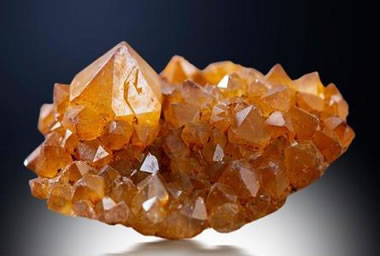
Citrine Crystals: A beautiful cluster of citrine crystal points with an orangy yellow color. Photo by Cagla Kohserli / Alamy Stock Photo.
Natural, Treated, Synthetic
Five categories of citrine exist in the gem and jewelry market. These are:
|
1. citrine with a natural color 2. citrine with a natural color, but enhanced by treatment 3. citrine produced by heating light amethyst 4. synthetic citrine (a man-made product) 5. imitation citrine (a man-made product that is not SiO2) |
All of these are legitimate products; however, sellers should always inform the customer when they are selling gems that have been treated, gems that might have been treated, and especially when they are selling synthetic or imitation materials. Here are a few reasons why...
Natural Color Citrine
Quartz with a natural citrine color is rare. Some people want this natural-color citrine and are willing to pay a premium price for it.

Heat-Treated Citrine: A section of an amethyst geode that was converted to citrine by heat treatment. Most citrine in the gem and jewelry market today is a result of heating amethyst. Image copyright iStockphoto / Abundancia.
Heat-Treated Citrine
Long ago, someone discovered that some lightly colored citrine could be heated to improve its color. It was also discovered that some light-colored amethyst could be heated to produce an attractive citrine color. This treatment works exceptionally well and is inexpensive. Today, most of the citrine entering the gem and jewelry market is heat-treated amethyst mined in eastern Brazil.
Most people are satisfied with natural color citrine that has been color-enhanced by heat treatment, or citrine that has been produced by heating light-colored amethyst. Many people don't even "think of" or "know of" these two possibilities. However, these are distinctly different products for some people. For that reason, a seller should inform buyers when the nature of the color is known, and honestly answer "we don't know the origin of the color" when they cannot answer with certainty.
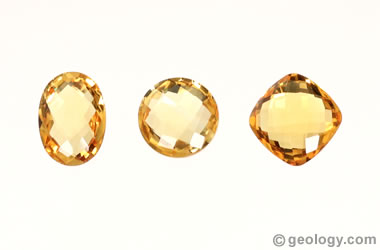
Synthetic Citrine: These gems were grown in a laboratory using the hydrothermal method and faceted with a checkerboard cut. The oval measures 14 x 10 millimeters, the round measures 12 millimeters across, and the square measures 14 millimeters from corner to corner.
Synthetic Citrine
Synthetic citrine is a man-made material that has the same chemical composition, mineral structure, and optical properties as natural citrine. Much synthetic citrine with a wonderful color and exceptional clarity is grown in Russia using the hydrothermal method.
Synthetic citrine is inexpensive and available in consistent colors and can be made in unlimited quantities. It is the perfect material for manufacturing a consistent brand of jewelry for a retail merchant with hundreds of stores. It can be grown to produce gems of almost any size and color.
The "wonderful clarity" means that it has very few inclusions. Those inclusions are one of the most reliable ways to separate natural citrine from synthetic citrine. This makes it very difficult or impossible for a gemologist, working with traditional tools, to differentiate natural citrine from synthetic citrine. But, many gem laboratories have scientific instruments that can reliably separate natural citrine from synthetic. These tests can often be done for less than $100. You can see a reliable lab's fee schedule here.
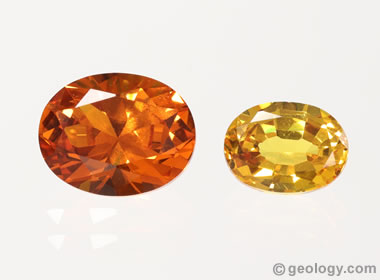
Imitation Citrine: Nanosital, a man-made glass-ceramic is often produced in colors that imitate citrine. The orange stone measures 10 x 8 millimeters, and the yellow stone measures 8 x 6 millimeters. Great color!
Imitation Citrine
Although citrine and topaz are not extremely expensive gems, man-made look-alikes are often used as even lower-cost substitutes than synthetics. Lab-created corundum in a yellow to orange color is sometimes used as a citrine simulant in inexpensive birthstone jewelry.
Synthetic corundum has a Mohs hardness of 9 and is very durable. The only gem that is harder than corundum (the mineral of ruby and sapphire) is diamond - which is much less likely to be scratched or broken than topaz or citrine. Synthetic corundum is a good low-cost substitute for citrine if a person is willing to accept a material that simply "looks like citrine".
Sources of Citrine
Small quantities of naturally colored citrine are found at many locations throughout the world. The frequency of its occurrence is demonstrated by the locality maps at mindat.org.
The most important commercial source of citrine with a natural yellow to orange color are the pegmatites of eastern Brazil. Other countries where citrine has been produced include: Argentina, Bolivia, Madagascar, Mexico, Russia, Spain, and Uruguay.
The most important source of amethyst that is heat treated to produce a citrine color is also eastern Brazil. Russia is the most important source of synthetic citrine.

Ametrine Rough: A beautiful piece of a very high quality ametrine crystal with richly colored amethyst and citrine in sharp contact with one another. A piece of rough like this could be used to cut spectacular gemstones or carvings. Photo courtesy of Minerales y Metales del Oriente S.R.L. and Ametrine.com.
Ametrine
Ametrine is a bicolor quartz that has zones of golden yellow citrine and deep purple amethyst in contact with one another in a single crystal. The origin of the name is a combination of AMEthyst and ciTRINE to yield "ametrine."
Ametrine is a rare gem, with most of the world's commercial ametrine production from the Anahi Mine in southeastern Bolivia. The mine produces a variety of ametrine, amethyst, citrine, rock crystal, and bicolor gems.
Much of the ametrine is cut into stones with a traditional 50/50 ametrine/citrine split - but there are many ways to cut ametrine to obtain a maximum yield of unique gems from the mine's production. The mine has been operated by Minerales y Metales del Oriente S.R.L. since 1989. The company is involved in mining, cutting, and jewelry production - to maximize the use of its ametrine resource.

Chakra stones: Citrine is a gem used as a chakra stone for the solar plexus. Chakras are "spiritual centers" of the body. Commonly used chakra stones include: amethyst (crown chakra), sodalite (brow chakra), blue lace agate (throat chakra), green aventurine (heart chakra), citrine (solar plexus chakra), carnelian (sacral chakra), and red jasper (root chakra). Image copyright iStockphoto / Artecke.
Citrine as a Healing Stone?
People have collected gem materials for thousands of years and marveled over their beauty. Through time and in all parts of the world, many people have believed that gem materials have the ability to heal, protect, or comfort a person who owns or wears them.
Even though there is no scientific evidence that gemstones have any healing or spiritual power, many people persist in these beliefs. Today, citrine is one of the most popular "healing stones." Millions of dollars per year are spent on citrine crystals, tumbled stones, beads and other citrine items for use in these practices.
| More Gemstones |
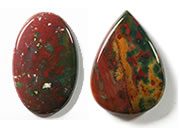 |
Bloodstone |
 |
Rock Tumblers |
 |
Diamond |
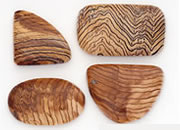 |
Opalized Wood |
 |
Tourmaline |
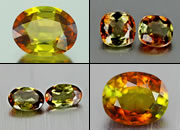 |
Andalusite |
 |
Blue Gemstones |
 |
100+ Gems |

Find Other Topics on Geology.com:

|

| ||

|

| ||

|

| ||

|

|

